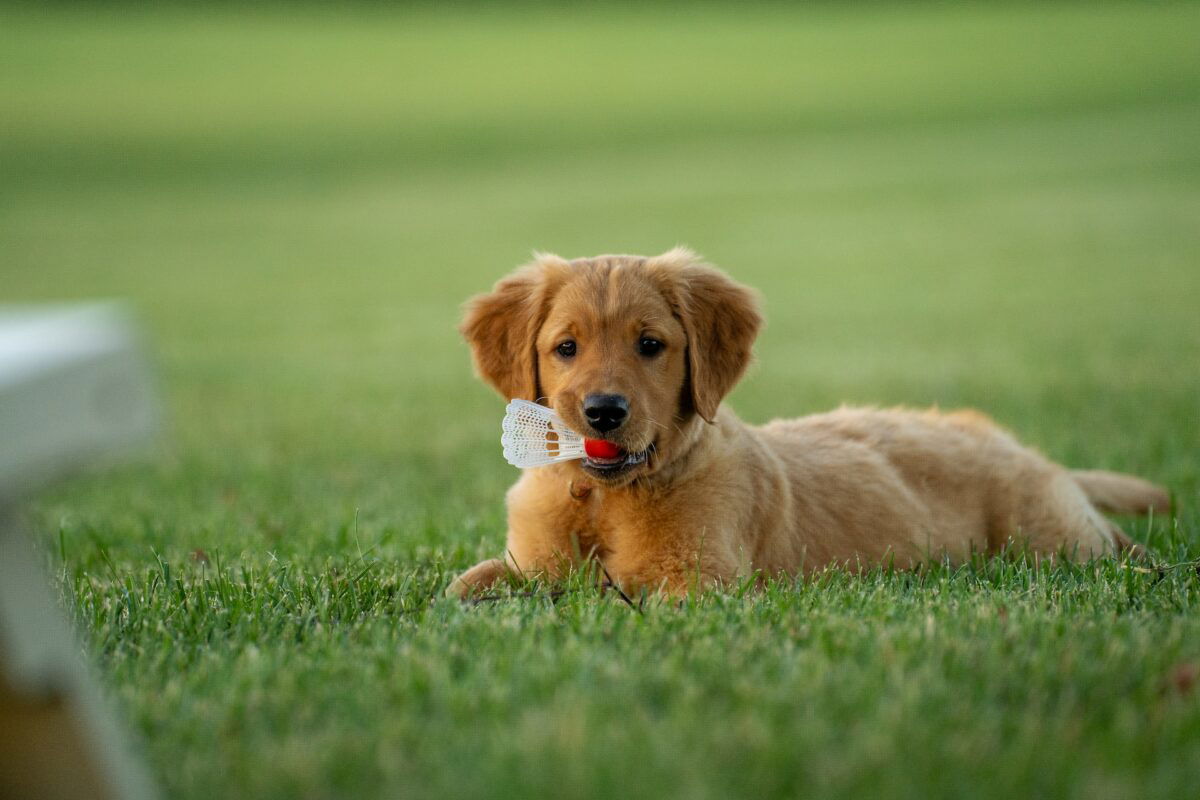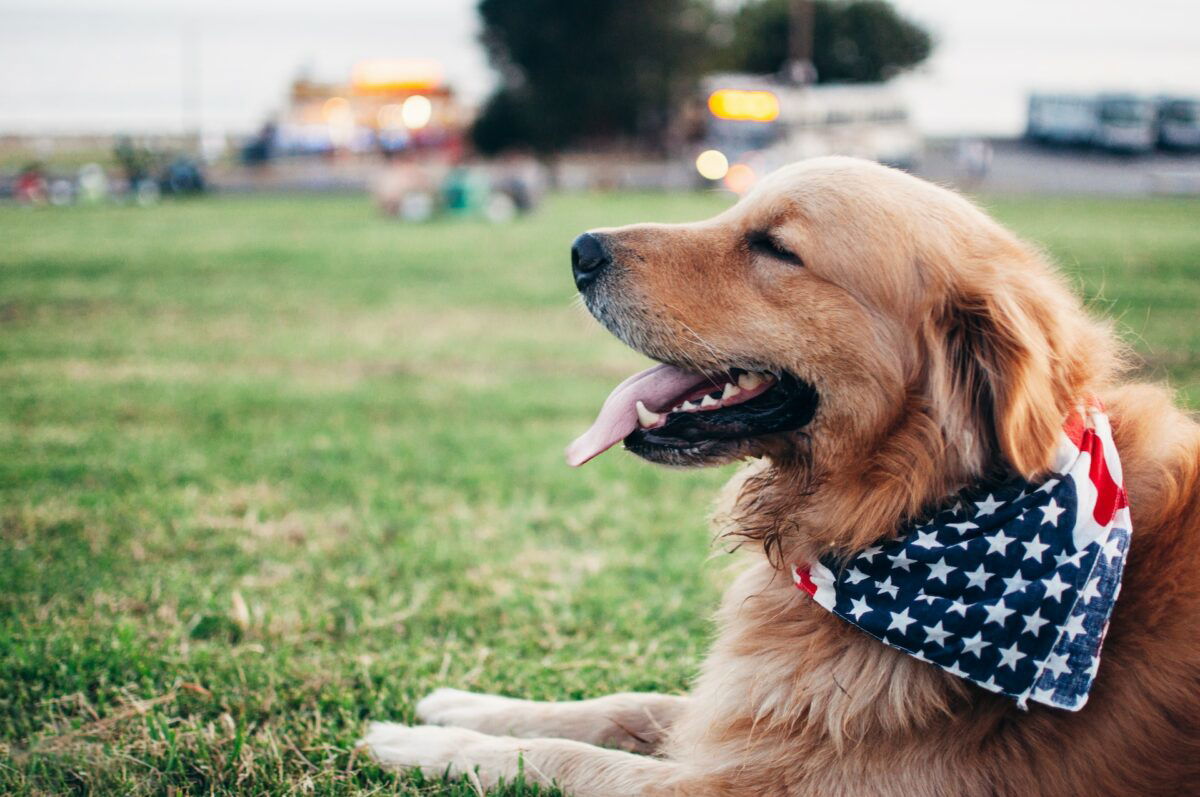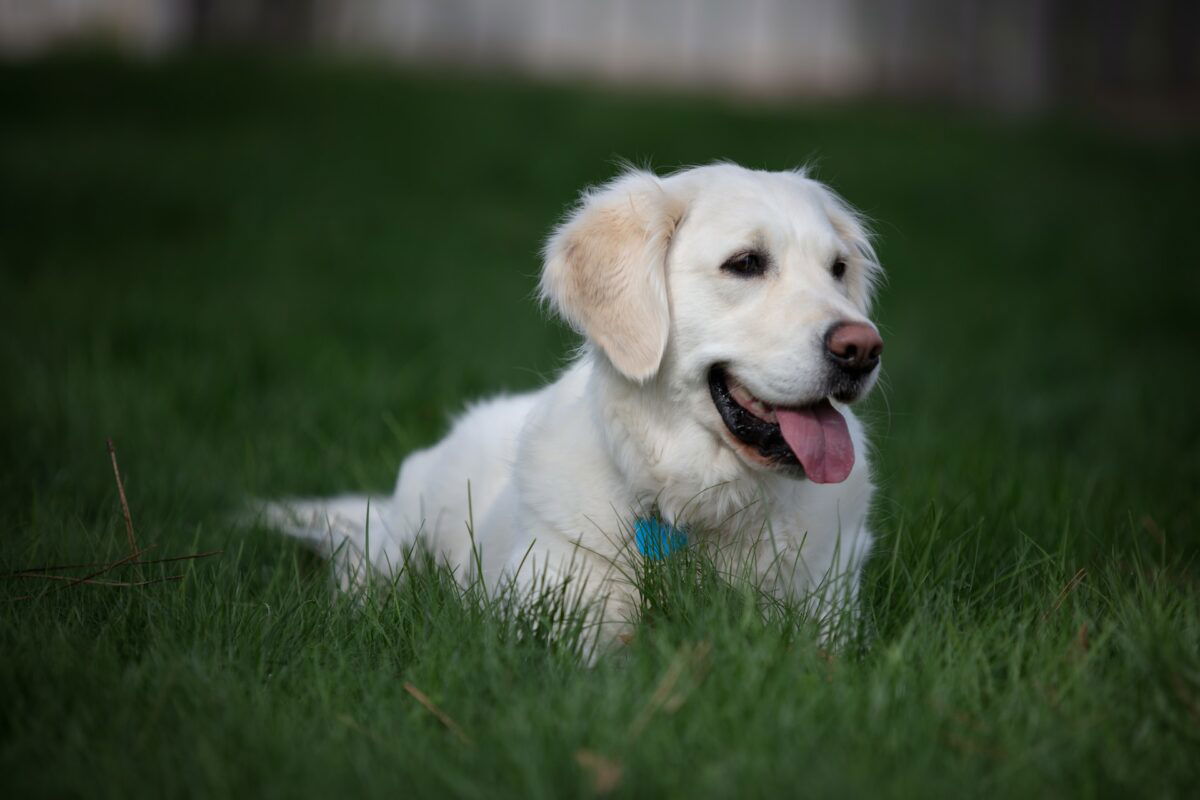We're an affiliate
We hope you love the products we recommend! Just so you know, we may collect a share of sales or other compensation from the links on this page at no additional cost to you. Thank you if you use our links, we really appreciate it!
If there are dog breeds that don’t need any introduction, then Golden Retrievers have to be one of them.
These fuzzy double-coated canines have been ranked among the top three most popular dog breeds in the USA for successive years.
Golden Retrievers have found a sweet spot in many households because of their friendly demeanor, desire to please, and impressive trainability.
There’s so much to say about Goldens, and we captured most of the necessary details that you need to know about these lovely canines in our comprehensive overview.
Whether you’re an aspiring Golden parent or you own one already, keep reading this guide to find out the nitty gritty that nobody told you about this dog.
What Is a Golden Retriever? – Brief History of Golden Retrievers
The history of Golden Retrievers can be dated back to the mid-19th century in Scotland, accredited to Sir. Dudley Coutts Majoribanks, who was later known as Lord Tweedmouth.
Scottish estate owners desired to create a dog breed that would help them retrieve gunned birds from the marshlands and hunting grounds in Scotland.
Baron of Tweedmouth started his breeding journey by crossing a yellow wavy-coated retriever named ‘Nous’ with a Tweed Spaniel named ‘Belle’.
This resulted in a litter of four puppies known as Primrose, Crocus, Ada, and Cowslip.
These offspring were later crossed with other desirable breeds such as Irish setters, bloodhounds, black retrievers, and St. Johns waterdog, which gave rise to the modern ‘Golden Retrievers’.
Golden Retrievers excelled in both land and water and their popularity grew from the highlands in Scotland over the UK and across other continents.
It was not until the 1890s when the Golden Retrievers were introduced to the US, and they were officially recognized as a breed by the American Kennel Club in 1925.
5 Interesting Facts About Golden Retrievers
1. Golden Retrievers were initially bred for hunting
Despite their abundance in households today, Golden Retrievers were originally bred for hunting and retrieving gunned birds from rivers. They were also helpful in chasing partridges, geese, and small game.
2. Golden Retrievers are highly intelligent
Renowned dog psychologist Dr. Stanley Coren did comprehensive research about the obedience and working intelligence of dogs and guess what, Golden Retrievers emerged fourth out of 138 breeds tested.
3. Golden Retrievers love working out
These charming double-coated canines are always ready for action, whether it’s a simple game of fetch or intensive outdoor activities like hiking.
Their natural athleticism and zeal for work got them categorized under the sporting group.
4. They are mouthy
Due to their intrinsic abilities to serve as retriever dogs, Golden Retrievers love carrying objects with their mouth with a soft bite. Be it a plush toy, stick, or food bowl, you can hardly find them with an empty mouth.
5. Golden Retrievers have a soft mouth
During the historic period, Golden Retrievers could retrieve gunned waterfowl to their owners without causing damage, and to this date, they are said to carry an egg without cracking the shell.
Golden Retriever Puppies
Owning Golden Retriever puppies can be a rewarding journey filled with joy, laughter, and charming kisses from the young canine.
These fuzzy pups can quickly become the most cherished members of your family due to their adorable antics and willingness to learn.

Make sure to housetrain and socialize your Golden puppy right from a young age to ensure they grow into becoming responsible adults.
It’s also worth mentioning that these little pups can be a bit mischievous, especially during adolescence!
Don’t be surprised if your Goldie puppy steals your socks or bites into your furniture when teething.
Golden Retriever Types
Despite having close personalities, Golden Retrievers exist in different purebred types, shades, and colors. The following are some of the major types of Golden Retrievers:
1. American Golden Retriever
The American Golden Retriever is perhaps the most common type of these dog breeds. They are widely considered the general standard for Goldies across different nations.
The most outstanding characteristic of American Golden Retrievers is their luscious gold coat, although some may have a darker or lighter shade.

American Goldies have a leaner physique compared to other breed variations and they also have a more playful and energetic temperament.
The impressive intelligence of these dogs and their outgoing nature make them a popular choice for people looking for service dogs.
2. British Golden Retrievers
The British Golden Retrievers share many traits with their American counterparts although they sport some subtle differences.
It wasn’t until 1932 that the British Kennel Club recognized the British Goldies as a standalone breed variation.

The British Goldies feature a lighter gold-colored shade than the American types. Some of them come with a shade of cream which most people refer to as ‘English Cream Golden Retrievers’.
British Goldens are a little bit shorter than the American variation, and most of them weigh between 55 – 70 pounds.
These dogs have been reported by many breeders to be less prone to suffer health conditions like hip and elbow dysplasia than their American cousins. (There are no studies to claim this assertion yet).
3. Canadian Golden Retrievers
There are just but a few variations that separate Canadian Golden Retrievers from their American cousins.
They are characterized by a thinner golden coat which can have different dark shades compared to other breed variations.

Canadian Golden Retrievers stand at nearly similar heights to their counterparts from the US, and they also fall within a comparable weight range.
4. English Cream Golden Retriever
Most people cherish the fluffy cream-colored coat that covers English Cream Golden Retrievers.
This dog type is a variation of the British Golden, and sometimes they are known as ‘Rare White European Retrievers’, thanks to their distinctive pale coats.

English Creams are among the most coveted Golden Retrievers across the world. Along with their stunning looks, these canines are known for their lovable persona, intellect, and friendly nature.
That’s why most people perceive them to have a calmer demeanor compared to the other variations.
English Cream Golden Retrievers are also the most expensive variation in this lot, because of their splendid appearance.
Golden Retriever Physical Characteristics
1. Size and weight
Golden Retrievers are considered large breed dogs although some variations like the English Cream are categorized as medium-sized.
A fully grown healthy Golden Retriever male can stand 23 to 24 inches from the ground while females have a height range of 21.5 to 22.5 inches.
In terms of weight, an adult male Golden Retriever can weigh between 65 to 75 pounds while their female counterparts can tip the scale within the range of 55 to 65 pounds.
2. Coat Color and Texture
The Golden Retrievers’ coat type, color, and texture are perhaps their most outstanding physical attributes.
These dogs have a dense water-repellant double coat which comes in various shades of gold, ranging from light to deep golden hue.
The texture on the outer coat can sometimes be straight or wavy in other breed variations, but they are generally characterized by fluffiness, especially around the neck, tail, and back of the legs.
Golden Retrievers undercoat is soft and insulating to protect them from heat or cold by keeping the temperatures regulated.
3. Distinctive features
Golden Retrievers have a complement of other distinctive features that set them apart from other popular dog breeds.
These dogs have a sturdy body build with a strong and broad head. Their well-balanced muscular limbs help them take part in various physical activities.
They have medium-sized eyes, which are typically dark brown, and exude a friendly expression to their human caregivers.
Another distinctive feature about Goldies is their tail, which is thick, fuzzy, and muscular at the base. The tail has bits of feathering along the underside which sets them apart from the crowd.
You can’t look at a Golden Retriever and fail to notice their medium-sized floppy ears, which are covered by soft featherings along the edges.
Golden Retriever Personality
Golden Retrievers are well-known for their charming persona and friendly nature which makes them one of the most dearly loved dog breeds in the world.
Their exceptional temperament, love, and devotion make them an ideal choice for most families looking for a household pet.
Their heart is big enough to form strong emotional connections with each member of the family, including toddlers and the elderly.

Golden Retrievers are good with children. These dogs have a calm demeanor, non-aggressive, and happy disposition which can make them a fantastic playmate for your kids.
If you’re considering getting a dog for the first time, then you can hardly go wrong with a Golden Retriever.
Their smartness and eagerness to please nature make them an excellent choice for people with and without experience handling dogs.
Golden Retrievers can also extend their heartwarming attitude to other pets within your household.
These charming dogs can easily get along with cats, other dog breeds, and other small household pets.
Golden Retriever Intelligence
Golden Retrievers are considered among the most intelligent dog breeds in the world. This assertion was proved by canine psychologist Dr. Coren in his book ‘The Intelligence of Dogs’.
Golden Retrievers emerged as the fourth smartest breed out of 138 different breeds tested during the research period.
These fluffy dogs excelled both in working intelligence and obedience, which makes them a good candidate for use in various roles including serving as therapy dogs.
Golden Retriever health and lifespan
Every pet parent should desire to know the common health issues associated with their favorite dog breed and their average lifespan.
Knowing this will keep you aware of the potential health complications that may strike your lovely dog to ensure you give them a well-deserving and happy life.
Average lifespan
Golden Retrievers have an average life expectancy of between 10 – 12 years. However, some Goldies may fall short of this range while others can live longer than 12 years.
Jennifer Hetterscheidt’s dog known as Augie is recorded as the longest-living Golden Retriever, having attained an age of 20 years and 11 months.
Common health issues and genetic disorders
Golden Retrievers are typically healthy dogs, but they can also be predisposed to certain health conditions due to poor breeding and environmental factors.
The following are some of the common health issues that can affect Goldies:
- Aortic Stenosis
- Orthopedic disorder
- Cancer
- Eye problems
- Skin condition
- Epilepsy
- Gastric-Dilatation-Volvulus complex (GDV)
Preventive measures for good health
It’s highly recommended to have a quarterly schedule for taking their dogs to the vet for general checkups. This puts your dog at a higher chance of recovery if any abnormal issue is suspected.
Your vet will also keep track of your dog’s vaccination schedule and ensure they get the prescribed shots and yearly boosters if needed.
Allowing your Golden Retriever to get enough sleep each day, especially after having a busy day is a great way of keeping them healthy.
Golden Retriever and Allergies
Due to their heavy shedding, Golden Retrievers are not considered hypoallergenic dog breeds. However, this does not mean that allergic people cannot live with these lovely dogs.

In addition to allergies from shedding, dogs can also cause a negative reaction to allergic people through the protein found in saliva, urine, and dander.
Golden Retriever Grooming Needs
1. Coat maintenance
Golden Retrievers, with their glossy and radiant double coats, require regular grooming to keep them looking great and feeling comfortable.
It’s recommended to brush your lovely Goldie regularly to help manage hair fall and prevent tangling or matting of the thick undercoat.
A thorough brush-down two or three times a week should be enough, but daily brushing is required during seasonal changes to keep up with heavy shedding.
It’s also important to bathe your Golden Retriever at least once every two months using dog-specific shampoos.
Regular grooming is good for hygiene and helps reduce doggy smell. Too frequent bathing should be avoided since it can strip off the natural oils from the dog, making the skin dry.
2. Ear cleaning
Golden Retrievers’ floppy ears are prone to ear infections, so it’s important to clean their ear canal with a vet-approved solution to prevent the buildup of pathogens.
3. Teeth brushing
For a full grooming routine, remember to brush your dog’s teeth using canine-specific toothpaste to keep them clean and prevent the rise of periodontal diseases.
4. Nail trimming
Keeping your dog’s nails short and clean is also important for their overall health and comfort when walking or playing.
Daily Activity Needs
Golden Retrievers are full of energy and they require constant physical and mental stimulation to keep them in good shape.
Regular exercise can also help your dog cut that extra weight and prevent obesity, which carries a greater risk of other chronic illnesses.
Suitable activities and games for Golden Retrievers
- Walks and runs
- Stairway dash
- Playing fetch
- Hide and seek
- Tug of war
- Swimming and water games
- Hiking
- Agility training
- Obedience training
- Bubble chaser
- Simulated hunts
Importance of mental stimulation
As much as physical activities and exercises are important for your Golden Retriever, mental stimulation also plays a crucial role in their overall well-being.
The following are some of the advantages of stimulating your golden pup mentally:
- Prevents boredom, anxiety, stress, and depression
- Enhances problem-solving skills
- Increased the dog’s brainpower
- Builds the dog’s socialization skills
- Slows down mental decline in elderly dogs
Golden Retriever Training and Socialization
Golden Retrievers are easy to train, thanks to their natural athleticism and inherent desire to please humans.
These lovely dogs can show positive progress when subjected to consistent physical and obedience training.
Social training is also an important aspect of keeping your Golden Retriever well-rounded, happy, and contented, by building their confidence.
We recommend socializing your dog right from their puppyhood stage by introducing them to different people, pets, and settings.
Golden Retriever Living Conditions
Golden Retrievers are highly adaptable canines, meaning they thrive in various living conditions such as apartments, and homes in the countryside, or suburbs.
All you need is to love your doggo and make sure they get enough exercise to meet their daily physical demands.
These dogs love being included in the family’s activities, so don’t shy off from tagging them along your dash to the grocery store.
Golden Retriever Diet & Nutrition
It’s always important to feed your Golden Retriever a high-quality balanced diet that supplies all the necessary nutrients to keep them healthy and strong.
Most dogs can thrive with a high protein diet, healthy fats, minimal carbohydrates, and a tiny taste of dog-safe fruits and vegetables for micronutrient supply.
Dog treats should not make up more than 10% of your dog’s daily meal plan. You may have to consult with your vet for a personalized diet recommendation that fits your dog’s specific needs.
Golden Retriever Pregnancy & Litter Size
The average gestation period for a healthy Golden Retriever is about 63 days, and the normal litter size can range from 6 to 8 puppies, with significant variations across individual dogs.
Various factors such as the health condition of the dog mother, breeding age, genetics, and the quality of prenatal care can affect the litter size.
Conclusion
There’s so much we can say about Golden Retrievers. The take-home point is that these dogs have a lovely persona and friendly demeanor that makes them a great choice for most families.
Their adorable physical attributes crowned with a beautiful smile and glossy double coat make Golden Retriever a dog that catches the attention of many.
Golden Retrievers are an embodiment of true human companionship, thanks to their heartwarming character and desire to please – no wonder they excel as therapy dogs!
Laura is the founder of Furs'n'Paws. She is a also a pet writer and expert with more than 20 years of experience of working with dogs and cats. She developed a very strong love for animals at a young age. Her passion led her to establish a thriving pet sitting and dog walking business in Dubai. As an expert in pet training, behavior, and nutrition, Laura is committed to helping pet owners and pet lovers by offering high-quality information on a wide range of topics.



No responses yet